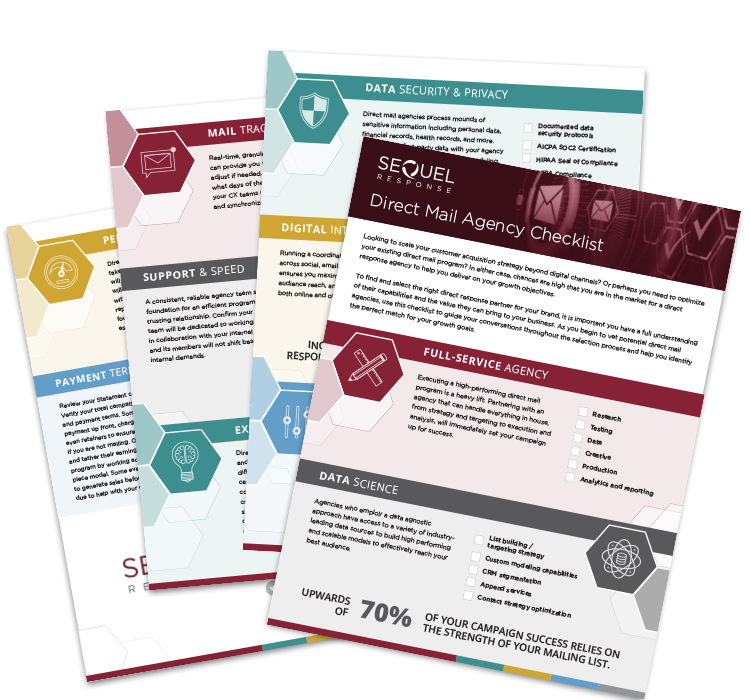Innovative Direct Mail Strategies for Debt Relief Brands

With the right strategies, financial services and debt settlement brands can convert leads to clients through targeted and well-designed direct mail campaigns. In this article, we’ll discuss how to leverage data analytics and personalization, retargeting, digital integration, and smart testing strategies to drive prospect engagement and conversions with debt relief direct mail.
|
Prefer to listen? Check out our podcast The Direct Effect: Innovative Direct Mail Strategies for Debt Relief Brands |
Personalization at scale
Trust and relevance are critical, especially in the debt relief and consolidation space.
Direct mail is already considered one of the most trustworthy advertising channels. Therefore, personalized direct mail is an effective way to engage potential customers and establish credibility with your audience. Including individualized elements in the piece will immediately increase the audience’s connection to your message, confirm its relevance, and naturally move them closer to conversion.
Through Variable Data Printing (VDP) and accurate data sources, debt settlement brands can customize single mail pieces without sacrificing printing efficiency. Leveraging customer data like income, debt amounts, or credit history allows you to craft tailored messages that vary not only by name or address, but by images, offers, and other personalized content. For example, a mail piece could include specific details about how much the recipient could save with a debt relief program or provide testimonials from individuals in similar financial situations.

Retarget leads, offline
While retargeting with digital channels is common, retargeting through direct mail will offer a unique and memorable way to re-engage potential customers.
Warm leads are more likely to convert than cold leads, as they have already shown an interest in your debt relief product or service. This higher likelihood of conversion helps lower your mail program costs and CPA, as you do not need to build a mailing list of prospects or waste budget on a blind or uninterested audience. Retargeting with direct mail can also shorten the sales cycle as your reminder will naturally guide them back to your funnel.
One effective strategy is to send direct mail pieces to prospects who have visited your website, engaged with an online ad, or abandoned a lead form. With the data collected from your website or CRM, you can generate timely and targeted mailers that address their specific interest, delivered during the valuable decision-making phase.
Maximize engagement across touchpoints
Leveraging direct mail retargeting strategies is just one example of how debt settlement brands can seamlessly integrate online and offline marketing channels for a cohesive and enjoyable experience for potential customers.
QR codes are a simple way to unite physical mail with digital engagement. The tracking data available via QR code scans allows you to monitor how recipients engage with your brand and the actions they take after scanning. Incorporating these powerful tools into your mail piece design provides a convenient and engaging way for recipients to interact immediately with your brand via a direct link to:
- Personalized landing pages
- Video testimonials and success stories
- Interactive debt calculators
- Instant call or schedule a free consultation
In addition to adding innovative digital elements to enhance your mail piece design, consider how you can engage your mailing list audience with online marketing efforts around your in-home window. With a multichannel prospecting approach across email, social media, display, and programmatic channels, you can surround your audience with unified messaging on their preferred medium. This strategy will maximize the response of your campaigns and keep your CPA low.

A testing strategy built for growth
Testing is the only way for mailers to identify what works, scale successful tactics, and refine overall direct mail strategy for sustainable performance.
Financial service brands should build a direct mail testing strategy that focuses on four key campaign elements: lists, offers, creative, and digital integrations. Start by refining your audience segments to ensure you are reaching the best prospects, then test various offers (such as interest rate reductions or fee waivers) to see what resonates best. Once you have a solid foundation, focus on testing creative elements like messaging, design, and CTAs to further boost performance. Finally, test the impact of digital integration to evaluate how a multichannel strategy influences engagement, acquisition costs, and conversions.
To measure the true lift of your direct mail efforts, utilize holdout groups. Holdout groups—those who do not receive your mail piece—serve as a baseline to measure the incremental impact of your campaign, providing a clearer picture of its effectiveness. This helps you make data-driven decisions and optimize future campaigns, ensuring every dollar spent is maximized for ROI.
Case studies: success stories in direct mail for debt relief
Examining real-world examples of successful direct mail campaigns can provide you with valuable insights and inspiration for your financial services brand. Here’s a few of our favorites.
A case study on personalization
When managing its own mail efforts led to challenges, a personal loan and debt consolidation company chose SeQuel for a fresh data-driven strategy. SeQuel tested two new audience segments that the company hadn’t previously targeted, producing response rates 35% higher than the typical control. Additionally, by targeting prospective clients with varying debt levels, the company maximized enrollments while minimizing the cost per dollar enrolled.
A case study on retargeting
A prime example of this retargeting strategy in action comes from a financial services brand that turned to SeQuel to convert warm leads who had shown interest online but did not action. SeQuel implemented a direct mail retargeting strategy targeting website visitors and abandoned form leads, using personalized mailers based on each prospect’s previous interactions. This approach re-engaged high-potential prospects at the right moment, boosting response rates, reducing CPA, and ultimately driving more conversions than digital channels alone.
A case study on multichannel strategies
A home equity loan brand partnered with SeQuel to enhance its in-house direct mail program performance with a multichannel targeting approach. SeQuel’s data-driven approach to list building identified a new audience of high-potential prospects. Then to further amplify results, SeQuel Surround was activated to target the same prospects with digital display ads during and after the direct mail drop. This integrated strategy led to a 30% lift over a holdout group and helped the brand meet its lead and enrollment goals while staying under its Cost Per Enrollment Cap (CPEC).
A case study on comprehensive testing
A debt settlement company was eager to expand beyond digital marketing channels and turned to direct mail for growth. Leveraging SeQuel’s FaQtor Test matrix, four creative concepts and a dozen list sources were evaluated over three months. This allowed the company to find the optimal mailing frequency and identify its highest-performing audience segments. The campaign’s results were impressive, driving 22,000 new customers in the first year. Now, direct mail accounts for one-sixth of the company’s new business.
___________
As debt relief brands navigate the complexities of modern marketing, direct mail remains a valuable tool for engaging potential clients. By embracing innovative strategies, integrating online and offline efforts, and leveraging data-driven insights, brands can optimize their campaigns, achieve their customer acquisition goals, and stay ahead of the competition.

